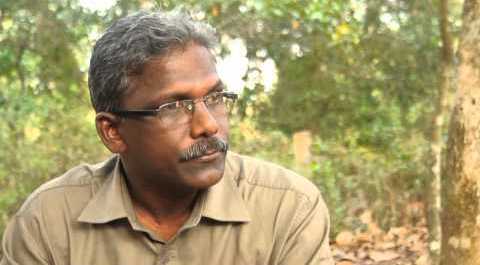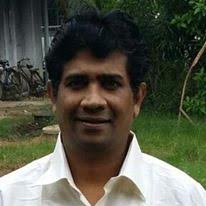[This interview with Sunny M. Kapicadu appeared first in the online Malayalam portal Utharakalam on April 17, 2014. He was interviewed by Dr O. K. Santhosh, Assistant Professor, University of Madras.
Sunny M. Kapicadu is one of the most prominent Dalit activists and intellectuals in Kerala. He has been active in all the subaltern protests in Kerala over the past few years. He is an employee of LIC.]

Dr O. K. Santhosh: Arundhati Roy’s long introduction to Annihilation of Caste (AoC) has generated much debate, particularly in the cyber and print media. Are these debates something more than mere controversies generated to bring attention to the Navayana edition? Since Roy’s right to write an introduction to Ambedkar’s most important work has been questioned, I think an explanation in this regard is necessary.
Sunny M. Kapicadu: The argument that only people with Dalit identity can talk about Ambedkar is fundamentally wrong. I think anybody can talk about Ambedkar. However, at the same time, it should be agreed that others have the freedom to analyze what is being written and spoken. Arundhati can write an introduction not only because Ambedkar has spoken about Buddhists and Sikhs (see “Arundhati replies to Dalit Camera”), she can write it otherwise as well. Ambedkar was the centre of discussions during and after the period of the nationalist movement. So if Arundhati has an opinion about Ambedkar, questions regarding whether she is a Dalit or has any sympathy for Dalits are not cardinal.
The issue is that AoC was an undelivered speech written in 1936 for Jat Pat Todak Mandal. Later, Ambedkar publishes it himself. Now, almost 80 years later, at this juncture, this book is coming out with an introduction. The important question is whether this introduction is for Ambedkar or for AoC. Two things could be considered important with regard to Arundhati writing an introduction. How did she suddenly get the right to write this introduction? It is clear that Anand, owner of Navayana, had recognised Arundhati’s stardom. Other than that, one cannot see any other right. I would support Arundhati, if she were to ask whether people in the limelight cannot have an opinion. She can say that. However, even if she agrees with this or not, one of the things that people think is that she has an image as an intellectual writer with substantial and uncompromising opinions. This image is the basis of her stardom. So when she hinges on that image to write about Ambedkar, the reality is that readers would tend to consider it as trustworthy.
Dr O. K. Santhosh: Isn’t it reductive to argue that it’s the stardom of Arundhati that is fuelling the current debates? Isn’t the presence of a Dalit discourse, developed through Ambedkar’s writings, that is problematising the issue?
Sunny M.Kapicadu: Stardom is going to influence her readers deeply. That’s why I said that an intense scrutiny is necessary. Otherwise, Anand would have to respond to questions regarding whether Arundhati has any qualification other than her stardom. As somebody who has read Arundhati and has an idea about her sensibility, I do not think she has any other right to talk about Ambedkar than this.
Another issue is with regard to the speculations around the publication of this book. Arundhati informed that she is cancelling the book release function in Hyderabad because there was this possibility of Dalit writers and activists disrupting the program. She has yet to reveal the source of these speculations. It was S. Anand who informed the media about this (see “Introducing Arundhati Roy and friends” by Karthik Navayan). What we should understand from such controversies is that they think that the Dalit intelligentsia has fallen to the level of physically confronting intellectual challenges raised against Ambedkarism.
In reality there is a Dalit intellectual terrain that is capable of confronting such challenges in India. Arundhati has to hang on to stories of violence precisely because she is unable to understand this. Questions that are being discussed now were raised because she has not been maintaining the requisite decency required for dealing with this issue. AoC, which was published in 1936, is one of the most read books of Ambedkar in India. The book, which was available for Rs. 8 then, has been translated into multiple languages and debated. AoC has inspired the formation of many large-scale social institutions and strong Dalit movements in India.
It is important to ask whether Arundhati has understood that this book has had a history of its own. If this aspect is not being seen, there is no point in rejecting the criticisms raised against her. Can somebody of Arundhati’s standing claim that she is oblivious to all of this? The fact that she doesn’t mention anywhere in her introduction that unlike Ambedkar’s other writings AoC has had a different history pushes us to think that she maintains a low opinion on this.
During times when publishers like Navayana were not around, people who were inspired by AoC translated it into their own languages and distributed it. That is the historical importance of this work.
Dr O. K. Santhosh: BSP leader Kanshi Ram has said that AoC was the book that influenced him the most.
Sunny M. Kapicadu: I think I will come to that later. One of the shortcomings of Arundhati Roy’s introduction is that it is ignorant of the anti-caste crusades that have been initiated by Dalits. If she had any knowledge in this regard, she would have pointed out the importance of AoC. She has not done that. This is the most crucial point discussed by Ambedkar. In AoC Ambedkar asks why is it that India’s savarnas, or the Brahminical system, instead of confronting caste, are posing obstacles to activities aimed at annihilating caste.
Dr O. K Santhosh: In this context, one could highlight what KP Ramanunni1 had written in the foreword to the novel Chavuthullal (2011) written by Raju K Vasu2. He had written that Ambedkar had led many agitations in Thiruvananthapuram. Should one interrogate the contradiction that Dalits are approaching writers who are clueless of history for getting forewords written for their books?
Sunny M. Kapicadu: Raju K Vasu looks at Ramanunni as a Malayalam writer with star value. Therefore, he believes that Ramanunni’s introduction would help his book. However, Ramanunni’s ignorance about Ambedkar is in reality a part of the ignorance of savarnas about their living conditions and caste. Arundhati’s ignorance is because of her lack of awareness of caste. The question as to whether this foreword was written only for AoC is important. If that were the case, she should have examined Ambedkar’s description of the operation of caste in Indian society and its social effects.
In the end, when he confronts the question of how to annihilate caste, Ambedkar concludes that it is quite difficult to eradicate caste. He says that as long as Brahmins maintain their intellectual dominance, these difficulties would not end. He points this as one of the important reasons why caste cannot be eradicated. So if Arundhati is writing a foreword to a book which deals with issues such as this, we expect new interpretations about caste and observations that matter to the present. However, this foreword does not do that but ends up doing certain other things.
Dr O. K. Santhosh: When Manorama-Penguin combine published Gail Omvedt’s book on Ambedkar in Malayalam, KK Kochu, one of the front ranking Malayali intellectuals, was assigned to write an introduction. Wasn’t Navayana also trying out such a possibility through Arundhati?
Sunny M. Kapicadu: It was S. Anand’s decision to republish the book and get Arundhati to write a foreword to the book. Annotations were prepared by Anand himself. Our discussion is about the aftereffects of these attempts made by Anand. A huge body of scholarship exists on Ambedkar and his writings. The greatest drawback is that the book chooses not to see this. Even if Anand did not see it, Arundhati should have seen it. This is because Anand might have had many commercial interests. If Arundhati writes a foreword, the book would sell internationally. Although he prefers to call himself an anti-caste publisher, a publication always has a business end to it.
Dr O. K. Santhosh: You are an acquaintance of Anand. Have you felt Anand has had such interests?
Sunny M. Kapicadu: I do not think Anand is all about marketing strategy. A marketing expert just would not depend on an existing market, but would create a new one. Anand is a good marketing expert, and in that sense he cannot be faulted. But when that marketing expertise operates through Ambedkar, my interest is in analysing what happens to Ambedkar’s ideas and the social upheavals generated by those ideas, and not in saying that Anand should not have brought out the book.
Dr O. K Santhosh: Ambedkar centenary was celebrated in India in 1992. During this time Ambedkar’s works were getting published widely in Maharashtra under the stewardship of Vasant Moon. In Malayalam too, as part of the project, the complete works of Ambedkar were being widely published and read. Does Arundhati’s study discard the fact that these publishing efforts engendered a resurrection of Dalit consciousness?
Sunny M.Kapicadu: We cannot look at it like that. What happened after Maharashtra government’s initiatives to publish the complete works of Ambedkar and publishing AoC with Arundhati Roy’s introduction cannot be compared. The new book performs a totally different function.
Dr O. K. Santhosh: Even now you keep referring to it as ‘Arundhati’s book’. Isn’t there the logic of stardom at work here?
Sunny M. Kapicadu: Not in the least. I have gone through the book; got it directly from Delhi for the purpose. One thing I have understood clearly is that this book is not about AoC. Arundhati’s foreword is the focus area of the book, as reflected in its sales. I claim that this book is Arundhati’s not because I am a fan of hers. I respect her as a writer, even as I am critical of her writings. Even if I am not personally close to her, I know her well. I neither worship nor harbour any enmity towards her.
From Ambedkar’s first paper, Castes in India:Their Mechanism, Genesis and Development, presented in 1916, the introductory study goes through the speeches made by him in the constituent assembly. However, Gandhi-Ambedkar controversy remains the crux of the introduction. The arguments in the introduction revolve around that core. Arundhati claims that she needed to talk about Gandhi a lot because she had to explain why Ambedkar felt the need to enter into a conflict with a great man like Gandhi. However, I do not think it is as innocent as she puts it.
Dr O. K. Santhosh: Ambedkar has written that it is wrong to think that if Gandhi were to speak no dog would bark in India.
Sunny M. Kapicadu: Yes, that is right, Ambedkar has written likewise. After the publication of AoC, although there was a welter of criticism, Ambedkar’s stance was that he would only respond to Gandhi, as Gandhi’s utterances were considered authoritative. No dog would bark in front of that authority. Ambedkar wrote that it was this aspect that prompted him to respond to Gandhi. We opened this discussion by talking about why Arundhati’s book was being criticized.
Due to her star power, there are readers who take her to be authentic. There is a mistake in that, and that’s why we are discussing it here. As an Ambedkarite, one of the epochal moments in Indian history for me had been the period when Dalits started considering Ambedkar beyond the framework of the Ambedkar-Gandhi controversy. During that period, Dalits started taking qualitative steps forward. That was a historical moment in India. I consider myself an Ambedkarite only because as far as I am concerned the light shone by Ambedkar is quite important for India.
Dr O. K. Santhosh: Another aspect is that, after visiting Dandakaranya, Arundhati Roy had written a long article entitled “Walking with the Comrades”. I think, after that, her image as an independent writer suffered a setback. The ripple effects of that article were felt among the Dalit-Adivasi movements and independent thinkers in India. Could she have written the foreword to Ambedkar as part of a strategy to tide over this setback?
Sunny M. Kapicadu: I do not know if there was any such move from her part. One should understand that even in this foreword she mentions the ‘great’ activities Maoists are engaged in. That is to say, it is discussed that Ambedkar was unable to understand the problems of the Adivasis correctly and what happens in Central India now is a very important movement. What we should understand is that Ambedkar’s constituency was that of Dalits, that of untouchables. He was not somebody who was involved in or led any Adivasi movements. But he has expressed many opinions on Adivasi issues.
Even Arundhati Roy expresses an opinion in this regard. It is about the issue of how other communities are not rooting for the progress of Adivasis. However, we should also be attentive to what Ambedkar is saying. He observes that since Dalits are a fragmented group in India, there are obstacles to their progress, but since Adivasis are concentrated region-wise, there is a possibility of them making advances in the future. We should know that, even as there is Maoist presence in Central India, there are many strong political leaders and chief ministers from tribal communities in the region.
It is merely a romantic imagination at work when a claim is made that with the creation of the Indian Constitution, the lives of Adivasis were destroyed. The Constitution, among other things, opens up the possibilities of Adivasi self-governance. What is the point in blaming the Constitution, if the state lacks the will to put in motion the possibilities offered by it?
The British government hadn’t invited any Adivasi representatives for the first, second, and third Round Table Conferences. However, three Dalit representatives attended these meetings. It was Ambedkar who confronted Gandhi during these meetings. When Arundhati argues that Gandhi was following Ambedkar’s logic as part of this context, she employs a shrewdness that can never be justified.
Dr O. K Santhosh: So is Arundhati Roy bringing a disguised form of Maoism to Dalit politics via this foreword?
Sunny M. Kapicadu: I believe her methodology melds all these elements. That is to say, discuss about constitutional impasses, at the same time raise Adivasi issues, and refer to Maoist movements. In this fashion there is an attempt to bring to us a Maoist sense of righteousness. There is no doubt about that. With surety we can say that there is a message which tries to convey the righteousness of Maoism in the foreword.
Dr O. K Santhosh: One of the key changes that have happened in the Hindu belt of Central India is the rise to power of subalterns and Dalits. For example, Mulayam Singh Yadav, Lalu Prasad Yadav, Mayawati, Nitish Kumar, among others. When Maoist ways are considered right, aren’t these progresses made invisible?
Sunny M. Kapicadu: I do not think Maoists in Central India are working towards solving the problems of the Adivasis, as claimed by Arundhati in the book. Maoists are working there because they consider it as a laboratory of Maoism to establish a dictatorship of the proletariat. Adivasi issue is just an immediate problem to be confronted as far as they are concerned. There are statements in the book which deliberately overlook the fact that Maoism is not a movement oriented towards solving the Adivasi problems in India.
Another issue is, she states that when talking about corruption there is no point in just blaming Mayawati. However, why doesn’t she understand that after Dr Ambedkar it was BSP’s emergence that truly created a fundamental rupture in Indian politics? Kanshi Ram was the leader of BSP. He said that he could not sleep after reading AoC. It is from that sleeplessness that the great Bahujan movement, BSP, came into existence.
No other example is required to make anybody understand the greatness of AoC. Arundhati is writing about a book which has changed the political destiny of people, a book which has influenced many individuals. That is a great responsibility to shoulder. I have to say that she has failed in fulfilling that responsibility.
(Translated from Malayalam by James Michael)
Please find links to all other articles on the issue here.
~
Notes
[1] K. P. Ramanunni is a novelist and short-story writer from Kerala.
[2] Raju K Vasu is a Dalit novelist from Kerala.
~~~
Picture courtesy: Dalit Camera.










